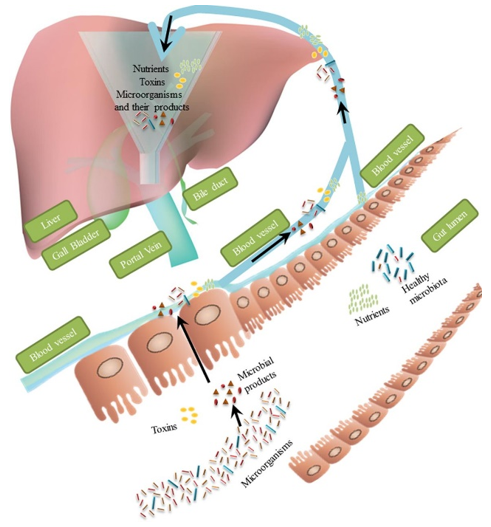The human gastrointestinal tract is colonized by a dense population of microbes that outnumber host cells 10-fold, which form communities of bacteria, viruses and microbial eukaryotes that are specific to people of different ages, diet habits, and health conditions. It is well known that gut microbiota plays relevant roles in physiological and pathological conditions of human health.
The gut microbiota or its metabolites can enter the liver through the portal vein, which has a great influence on the liver. The liver-intestinal axis is an important part to understand the pathophysiology of several liver diseases, and the gut-liver axis – a consequence of a close anatomical and functional, bidirectional interaction of the gastrointestinal tract and liver, has attracted numerous studies in recent years which focused on the coincidence between gut microbiota and infectious and non-infectious liver diseases.
Figure 1. An illustration of liver-intestinal axis substances flow. (Chu 2019)
CD Genomics is a preeminent corporation that specializes in multi-omics. Equipped with state-of-the-art techniques and served by well-experienced scientists, we have extensive experience dealing with all kinds of difficulties you may have encountered in your research, and we will provide the most valid solutions to meet your needs. Our knowledge about the intrinsic mechanisms of the gut microbiota-liver interaction and potential therapeutic options for gut microbiota-associated liver diseases are just starting to take shape, and the current multi-omics era promises rapid progress at the global level towards these research topics. We provide powerful tools to support your gut microbiota and liver research from the following multiple views:
Gut Microbiota Composition:
Aberrant changes in the composition of gut microbiota may indicate the shift of the host’s health condition; lateral comparison of microbiota composition between healthy and disease-burden individuals may as well uncover the intrinsic correlation between gut microbiota and liver-related diseases. We provide a wide range of technologies for gut microbiota composition profiling. Our specialty lies in multi-omics analysis mainly by state-of-the-art detecting methods coupled with bioinformatics analysis platforms. We provide all kinds of sequencing and gene array technologies to profile target sequences, (meta)genome, and (meta)transcriptome of all types of microbes, in order to offer the most comprehensive information on the microbiota composition of different individuals across liver-intestinal axis:
- Amplicon sequencing
- Whole-genome sequencing
- Metagenomic sequencing
- Virome sequencing
- DNA microarray
- Metatranscriptomics solutions
Gut Microbiota Metabolism:
Gut microbial metabolites and other marker molecules including bile acid and its related receptors (such as FXR, TGR5, CXCR6) are critical indicators to investigate liver-intestinal axis and liver diseases. We provide functional analysis of all kinds of intestinal metabolites and key substances by cutting-edge technologies including high-performance liquid chromatography (HPLC), nuclear magnetic resonance (NMR) spectroscopy, mass spectrometry (MS) and many other efficient equipment, in order to investigate the physiological status of both the microbiota and the hosts, identify various potential biomarkers, map unique metabolome fingerprints of specific cellular processes, determine specific pathways, and unveil fundamental mechanisms of certain diseases.
Link with Fitness and Diseases:
Evidence suggests that gut microbiota is associated with various chronic liver diseases including chronic hepatitis B (CHB), chronic hepatitis C (CHC), alcoholic liver disease (ALD), hepatocellular carcinoma (HCC), non-alcoholic fatty liver disease (NAFLD), non-alcoholic steatohepatitis (NASH), development of liver cirrhosis, and hepatic encephalopathy (HE), with abnormality presents in the ratio change of certain microbes or their metabolites. We provide solutions including comprehensive multi-omics techniques, powerful bioinformatics, and a variety of model organisms to address these issues:
Potential Therapeutic Options
Well-designed metabolomics studies and related animal studies will provide insights into the pathogenesis of liver diseases and promote the development of new treatment methods. Fecal transplantation, antibiotics, probiotics, prebiotics, and symbiotics are all potential options for gut microbiota manipulation and for the treatment of different liver diseases. But not all approaches have the same impact on gut microbiota modulation nor gut-liver axis pathogenesis process, a large number of specific studies still need to be done.
CD Genomics dedicates to providing the highest level of service in gut microbiota research. We will offer the most suitable strategies according to your sample and research purpose. To find out more about the services we offer for gut microbiota and liver research, please feel free to contact us.
Reference:
1. Chu H, et al. Small metabolites, possible big changes: a microbiota-centered view of non-alcoholic fatty liver disease. Gut. 2019, 68(2):359.
*For Research Use Only. Not for use in diagnostic procedures.


